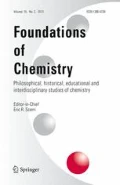Abstract
According to ‘standard histories’ of nanotechnology, the colorful pictures of atoms produced by scanning probe microscopists since the 1980s essentially inspired visions of molecular nanotechnology. In this paper, I provide an entirely different account that, nonetheless, refers to aesthetic inspiration, First, I argue that the basic idea of molecular nanotechnology, i.e., producing molecular devices, has been the goal of supramolecular chemistry that emerged earlier, without being called nanotechnology. Secondly, I argue that in supramolecular chemistry the production of molecular devices was inspired by an aesthetic phenomenon of gestalt switch, by certain images that referred to both molecules and ordinary objects, and thus symbolically bridged the two worlds. This opened up a new way of perceiving and drawing molecular images and new approaches to chemical synthesis. Employing Umberto Eco’s semiotic theory of aesthetics, I analyze the gestalt switch and the inspiration to build molecular devices and to develop a new sign language for supramolecular chemistry. More generally, I argue that aesthetic phenomena can play an important role in directing scientific research and that aesthetic theories can help understand such dynamics, such that they need to be considered in philosophy of science.
Similar content being viewed by others
References
D. Baird and A. Shew. Probing the History of Scanning Tunneling Microscopy. In D. Baird, A. Nordmann and J. Schummer (Eds.), Discovering the Nanoscale, pp. 145–156. Amsterdam: IOS Press, 2004
D. Baird, A. Nordmann and J. Schummer (Eds.), Discovering the Nanoscale. Amsterdam: IOS Press, 2004
Balzani V, Credi A, Raymo F.M and Stoddart J.F (2000). Artificial Molecular Machines. Angewandte Chemie International Edition 39: 3348–91
Balzani V, Credi A and Venturi M (2003). Molecular Devices and Machines: A Journey into the Nanoworld. Wiley-VCH, Weinheim
K.E. Drexler. Engines of Creation: The Coming Era of Nanotechnology. New York: Anchor Pr., Doubleday, 1986
U. Eco. Opera aperta. Milano: Bompiani, 1962 (Engl. trans. as The Open Work, Hutchinson, 1989)
U. Eco. La struttura assente, Bompiani, 1968.
U. Eco. A Theory of Semiotics, Indiana University Press, 1976.
A. Hessenbruch. Nanotechnology and the Negotiation of Novelty. In D. Baird, A. Nordmann and J. Schummer (Eds.), Discovering the Nanoscale, pp. 135–145. Amsterdam: IOS Press, 2004
Lehn J.-M (1988). Supramolecular Chemistry - Scope and Perspectives: Molecules, Supermolecules and Molecular Devices (Nobel Lecture). Angewandte Chemie International Edition 27: 89–112
J.M. Lehn. Supramolecular Chemistry: Concepts and Perspectives, VCH, 1995.
Lowey S (2003). So Near and Yet so Far from Understanding Molecular Motors: Recollections in Honor of John T. Edsall. Biophysical Chemistry 100: 171–175
C. Mody. How Probe Microscopists Became Nanotechnologists. In D. Baird, A. Nordmann and J. Schummer (Eds.), Discovering the Nanoscale, pp. 119–133. Amsterdam: IOS Press, 2004
G. Schill. Catenanes, Rotaxanes, and Knots, Academic Press, 1971.
Schummer J (1995). Ist die Chemie eine schöne Kunst: Zum Verhältnis von Kunst und Wissenschaft. Zeitschrift für Ästhetik and Allgemeine Kunstwissenschaft 40: 145–78
Schummer J (1998). The Chemical Core of Chemistry. I: A Conceptual Approach. Hyle 4: 129–162
Schummer J (2003). Aesthetics of Chemical Products: Materials, Molecules and Molecular Models. Hyle 9: 73–104
J. Schummer. Reading Nano: The Public Interest in Nanotechnology as Reflected in Book Purchase Patterns. Public Understanding of Science 14: 163–183, 2005
J. Schummer. The Twisted History of Supramolecular Chemistry. (Unpublished Paper Presented at the Cain Conference “Nano Before There was Nano: Historical Perspectives on the Constituent Communities of Nanotechnology”, Chemical Heritage Foundation, Philadelphia, PA, 18–19 March 2005)
F. Vögtle. Reizvolle Moleküle in der Organischen Chemie. Stuttgart: Teubner, 1989a (Engl. trans. as Fascinating Molecules in Organic Chemistry. Chichester: Wiley, 1992)
F. Vögtle. Supramolekulare Chemie. Stuttgart. Teubner, 1989b (Engl. trans. as Supramolecular Chemistry, Chichester: Wiley, 1991)
F. Vögtle. Cyclophan-Chemie. Stuttgart: Teubner, 1990 (Engl. trans. as Cyclophane Chemistry. Chichester: Wiley, 1993)
F. Vögtle, L. Rossa and W, Bunzel. Schöne Moleküle in der organischen Chemie. Kontakte 2: 37–48, 1982 (partly reprinted in: Chemie für Labor und Betrieb 35: 178–179, 1984)
Author information
Authors and Affiliations
Corresponding author
Rights and permissions
About this article
Cite this article
Schummer, J. Gestalt Switch in Molecular Image Perception: The Aesthetic Origin of Molecular Nanotechnology in Supramolecular Chemistry. Found Chem 8, 53–72 (2006). https://doi.org/10.1007/s10698-005-3358-5
Published:
Issue Date:
DOI: https://doi.org/10.1007/s10698-005-3358-5




